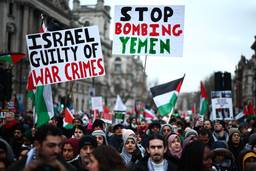Unexploded Ordnance: Our Legacy in Laos
unexploded bombs still killing people in Laos decades after Vietnam.
Terry J. Allen
As the years pass and the men who dropped the bombs expire in their beds, the rate at which Laotians die from U.S. unexploded ordnance (UXO) rises.
Since the end of the Vietnam War, the millions of yellow cluster bombs that litter Laos have claimed more than three times as many dead as the World Trade Center attacks.
Thanghon is one of the “lucky” thousands who have survived. Sitting in a wheelchair, she talked through a translator in Vientiane, the backwater capital of a backwater country that lies curled like a sleeping cat along the Mekong River.
“I was working on the family farm and digging in the ground when a UXO exploded,” she says. “Two of my friends died.”
“I came to Vientiane for the amputations. It took three days and two nights by bus,” she continues. “I was at the point of death.” Thanghon lost both her legs and the use of one hand after a hoe struck a quarter-century-old “bombie.”
A member of the Liu minority, Thanghon, 40, grew up in a small village in Phongsali province. From 1964 to 1973, the United States bombed the area as part of its illegal and “secret” war to disrupt the Ho Chi Minh Trail and undermine the Viet Cong supply route into Vietnam.
During those nine years, Laos, a country the size of Oklahoma, absorbed 2 million tons of American bombs, more than all the munitions dropped on Germany during WWII. On average, a planeload of bombs rained down every eight minutes, around the clock.
The ironically bad news is that up to a third of the fragmentation devices failed to explode. Instead, they turned Laos into an obstacle course where death and dismemberment is the penalty for one wrong step or misplaced hoe. Anything – or nothing – can set off these anti-personnel bombs. Typically, the victims are farmers trying to eke out a living and children, who are attracted by the bright yellow balls.
The country’s scarcity of arable land and abundance of poverty are driving the rise in accidents. Desperate farmers must weigh certain hunger against incalculable risk to grow food in fertile but mine-laced fields.
Unscrupulous scrap metal dealers from neighboring Vietnam are cashing in. As metal prices increase, UXO are becoming a cash crop. Dealers entice Laotians to hunt shrapnel and bombs by lending or renting them metal detectors. Farmers who earn a few hundred dollars a year are gambling life and limb for metal that brings a few dollars a pound.
Laos is a desperately poor country with an inadequate health system and an average life expectancy of 59 years. The disabled here have few options unless they reach Vientiane’s National Rehabilitation Center, a dusty complex of rustic buildings on the edge of town.
It survives on a trickle of domestic and foreign funds, but the United States, which caused most of these injuries, has done little to redress the damage or prevent more. In a post-Cold-War world, Laos is an inconsequential anachronism with little strategic value and less oil. What U.S. policy there is toward Vientiane is largely in thrall to the Lao Veterans of America, a California-based group largely comprised of Hmong people recruited by the CIA to fight Communism.
The Hmong lobby opposes aid to Laos – even for clearing mines. In this – and the influence it wields in a few Congressional districts – Hmong interest groups resemble the anti-Castro Cubans: Each group so despises the current government that it would strangle the populace rather than bolster the rulers.
I ask Thanghon if she is angry at the people who dropped the bombs.
“No,” she says. “We don’t hate them, but we don’t understand why we were fighting. It is our bad luck to be bombed.”
Bad luck may explain a particular victim, but had little do with Washington’s decision to bomb a neutral country. As part of a Cold War strategy, Presidents Kennedy and then Nixon pursued the Laos campaign in secret, without the consent of Congress or the American people. In addition to the bombies, U.S. planes dropped napalm and dioxin – chemical weapons that persist today, poisoning land, water and people.
The Geneva Convention banning chemical weapons was only one legal nicety Washington ignored. The other was the secret war itself, which violated international laws prohibiting attacks on neutral countries. A member of the committee that impeached Nixon, Elizabeth Holtzman, argued at the time that the secret bombing campaigns should have been high on the list of Nixon’s impeachable crimes. Wary of turning the impeachment proceedings into a forum on the war, the committee omitted the issue.
That failure of Congress and the courts to stop an illegal war and to hold a president accountable for war crimes resonates today, not only for Thangnon and Laos’ current and future casualties, but for a new set of victims in Iraq, in the U.S. armed forces and in sequestered prisons around the world.









